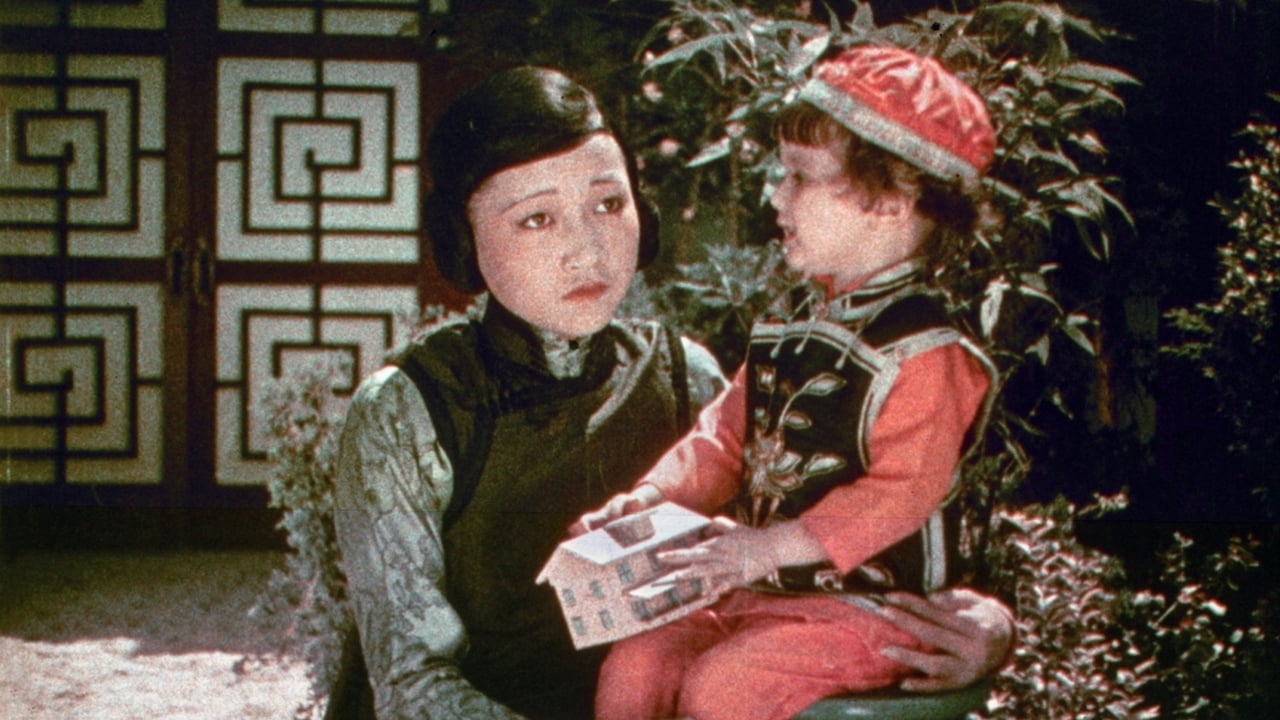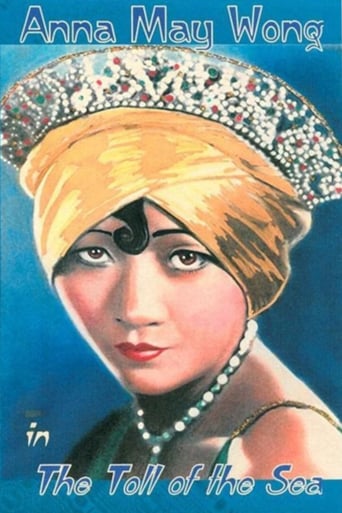

Plot so thin, it passes unnoticed.
... View MoreFrom my favorite movies..
... View MoreIt's the kind of movie you'll want to see a second time with someone who hasn't seen it yet, to remember what it was like to watch it for the first time.
... View MoreThe movie's neither hopeful in contrived ways, nor hopeless in different contrived ways. Somehow it manages to be wonderful
... View MoreI just finished watching "The Toll of the Sea" for the first time. What a beautiful and moving film! Anna May Wong was perfect in her "Butterfly "role as Lotus Flower. She was so beautiful and had such wonderful expressiveness in her face, eyes, movements, gestures. It was a performance that mesmerised me, that touched me profoundly. And she was only a teenager when she made that film! In the end, the other characters are really only supporting props for her portrayal of a deeply wounded and utterly sacrificial love for a shallow husband and sweet child. The supporting actors do their jobs effectively but it is Lotus Blossom we care for most. To think that this gem was thought lost! This is the first time I've seen an entire silent film using The two-strip Technicolor technique. I've only seen clips from "The Black Pirate", the sequences in "Ben Hur" and the Exodus episode from "The Ten Commandments". I found its use in "The Toll of the Sea" very effective, particularly in conveying an ambiance of the exotic in the film and adding lustre and richness to the settings. I haven't thought too much about the personal emotional impact it may have on the viewer. When I watch the film again I'll try to analyse this factor.The piano score has a very nice delicacy which underlines the feelings and reactions of the various characters. I thought it quite sensitive and telling.An utterly beautiful film!
... View MoreIt's slow going in this Puccini Opera rip off that nevertheless is worth a look for it's early example of the Technicolor process. The film plods along at a mostly gloomy pace as the camera looks for any reason to display color. From costumes to pheasants, gardens to elaborate Chinese interiors we are offered a full range of lush colorful imagery.Without the music Madame Butterfly can be trying but Anna May Wong as Lotus Flower gives a delicately touching performance being lurched back and forth between joy and tragedy. Her silent emoting in colorful costume makes for a beautiful visual poem. Kenneth Harlan as the bigamist has the Arrow man look and his American wife played by Beatrice Bentley evokes Gibson Girl remaining mostly in profile as if posing for the period calender.Lethargic pace and glum plot aside, Toll of the Sea's colorful historical significance and Ms. Wong's tender performance deserves a look.
... View MoreIn continuing its month of Chinese American cinema, Turner Classic Movies showed THE TOLL OF THE SEA tonight (which night highlighted some of the work of Anna May Wong. The Chinese-American actress was as big a star as Sessue Hayakawa was in the silent and early talkie periods, and certainly had much going for her: not only an ability to have the motion picture camera "love her" face and motions, but a sexiness that could easily be turned on. But she had problems finding leading parts, and usually had to accept better-than-average supporting roles (usually as a villainous - see the Sherlock Holmes film, A STUDY IN SCARLET with Reginald Owen for an example). Her best recalled role to most people is the young Chinese bride headed to the hinterland to meet her husband to be, who is the subject of the sexual desires of war lord Warner Oland in SHANGHAI EXPRESS. It was a good performance under a master director (Von Sternberg), and one of the few times Marlene Dietrich had competition from a female actress in one of Dietrich's films.This role was Anna's break-out part. Written for the screen by Frances Marion, the fabled great woman's screenplay writer in the early film period, it was also the first full length color film using a new two color strip system. Anna plays Lotus Flower, a naive young lady who helps rescue a drowning man named Allan Carver (Kenneth Harlan). Carver, while recovering, finds himself falling for Lotus Flower and he woos her. Then he gets word from home that he has to return. So he shows that fatal weakness in character that the screenplay makes us expect: he's talked by friends into dropping Lotus by not talking her back to the U.S. with him. She has been hoping to go with him, but now has to beat back disappointment. Still she feels she can count on Allan, as they have gone through some type of ceremony of marriage in China (although it is one that Americans might not accept). So she expects Allan will return.Years pass. Lotus was pregnant by Allan, and now has a four year old son (Priscilla "Baby" Moran plays the little boy). To him she keeps saying that one day his daddy will come home to them. But he doesn't. Then Allan shows up with his American (i.e. Caucasian) bride "Elsie" (Beatrice Bently). Lotus gives him up in a civilized manner, but then also gives up her son to be raised by Elsie and Allan. Then she commits suicide by throwing herself into the sea at the base of her garden.The reader may believe this is a rip-off by Frances Marion of the play and later opera MADAME BUTTERFLY. All missing is the heroine blindfolding her son, putting an American flag in his hand, and committing hara-kiri (but Anna is playing a Chinese, not a Japanese). Also this is a silent film with no bars of Puccini in it. But they have the next best thing, complete with a suicide. On the positive part the film has Wong acting with dignity and sweetness as a young girl who believes too much in romance and her lover's honor. She is constantly seen trying to keep her idea of his memory alive, despite the nay-sayers around her (personified by two catty gossips played by Etta Ling and Ming Young). She tries desperately to retain her optimism, and prays that her lover returns. But we are told that the sea is unforgiving, and for every instance of happiness it produces it demands repayment that is heavy and cruel. Like the sea waves it causes the person's euphoria to rise higher and higher, and then hit troughs pulling it lower and lower. Certainly the film keeps this idea in our mind. What will happen to our heroine and her son?The film as we have it now only has about 90 to 90% of the original in it. The last five minutes were lost, and had to be re-shot with a similar two tone color strip film and camera. But we see from a design in one of the last dialog cards shows a picture of Lotus Flower in the water sinking (only her head is above water. So we know how it ends.For all the similarity of the film to the opera, THE TOLL OF THE SEA is well photographed and Anna May Wong shows a nice chemistry with the motion film camera. The other actors are competent (the best being the two catty scolds who keep warning and laughing at Lotus Flower). Kenneth Harlan is not a bad actor but he oddly reminds me of Oscar Shaw, the Broadway "juvenile" star of the 1920s who played with Mary Eaton on Broadway, and appeared opposite the Marx Brothers in THE COCONUTS. The resemblance is quite odd. The actress who played his American wife was pleasant - nothing more. The little "boy" (Miss Moran) is enjoyably sweet as the child, and makes the slow torment Lotus Flower goes through all the worse to the audience.But it is really Wong who makes the story work - she is fully aware that she is unfairly being pushed out of a relationship that she thought would last forever. Her youth makes it more poignant. In the end we can understand why her career would last as long as it did, and why she became America's first Chinese - American film star.
... View MoreUp until I saw this movie, I thought that THE BLACK PIRATE (with Douglas Fairbanks) was the first color film entirely shot using the two-color Technicolor process. However, this pirate film debuted four years after THE TOLL OF THE SEA, so the dust jacket from the Kino version of THE BLACK PIRATE was mistaken by proclaiming it the first. This might be because up until quite recently, THE TOLL OF THE SEA was thought to be lost. However, a print was recently found and restored with all but the last couple minutes available for viewing on The Treasures of the American Film Archives DVD series.Being a two-color process film, the color seems very archaic. That's because unlike true color film, the two-color process involves special cameras with overlapping strips of film--one orange-red and the other green-blue. As a result, the print tends to look too orangy-green and colors like yellows and true blues and reds are non-existent. Probably the best example of the use of this process is in the small color segment of PHANTOM OF THE OPERA (1925), as they somehow DID get a nearly perfect red for the Phantom's costume at the ball. It's a gorgeous scene and if you are a nut about early films (like me), then it's imperative you see this restored print as well as THE TOLL OF THE SEA.TOLL OF THE SEA is actually a pretty good film--even viewed today. What I especially like is that the film has a wonderful message about race and features honest-to-goodness Chinese actors and actresses in the film. In the 30s and 40s, Asians rarely every played leads (like Anna May Wong did in this movie). Think about it--Sidney Toler, Boris Karloff, Peter Lorre, Paul Muni and even Katherine Hepburn played leads in films about Asians or Asian-Americans only a decade or two after this film!!!!! Ms. Wong plays a nice lady who finds a sailor washed up on the shore. She nurses him back to health and they fall in love. He later goes back to his country and vows to return to get her. However, time passes and she is left waiting,...along with the little bastard she bore this unworthy jerk. So far, I really liked the film. However, when the guy returns some time later with his White wife, the film has a less than perfect conclusion--at least for me. I won't say anything more, but the film was pretty sad and left me feeling a bit down when it was finished.Overall, a very good film that is worth seeing for all fans of early cinema.
... View More